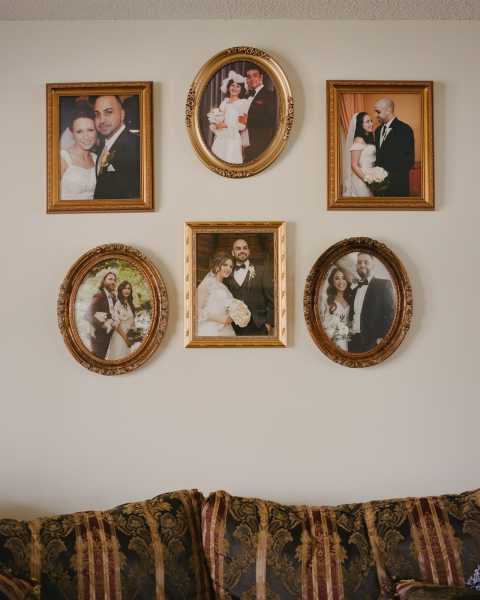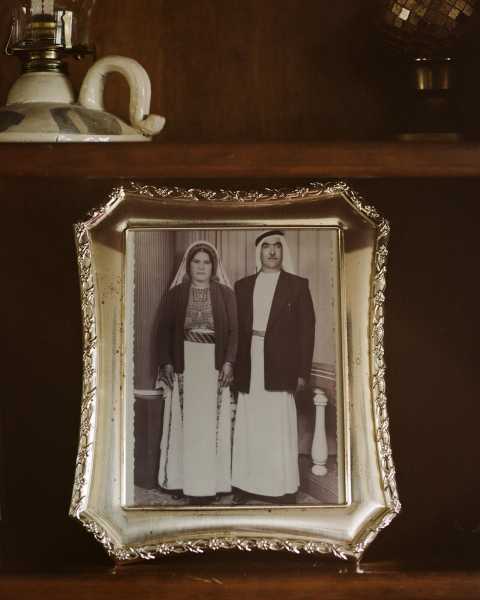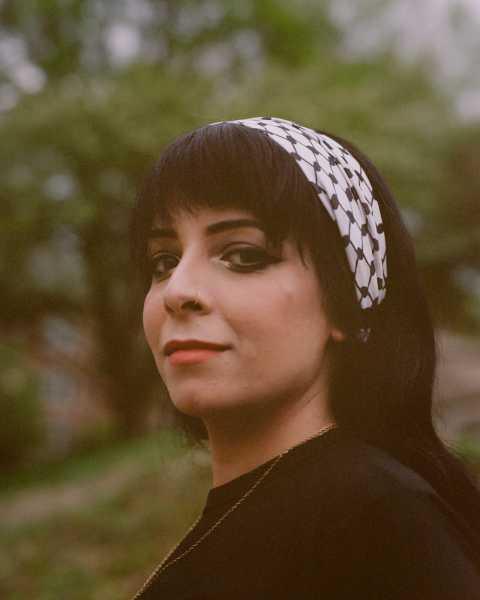
Save this storySave this storySave this storySave this story
In 1987, when Palestinians rose up against the Israeli occupation in what would become known as the first intifada, I was six years old. Each evening, when Peter Jennings delivered the six-thirty news, my family would gather in our wood-panelled basement, in the suburbs of Washington, D.C., and watch for images of Nablus, where we’re from. We saw young Palestinians, in jeans and bandanas, throwing a seemingly endless supply of stones; Israeli soldiers, in tan uniforms and combat boots, guarding checkpoints, looking both vigilant and bored; coffins shrouded in Palestinian flags. Our lives in America were at a cool remove from the conflict. I spent those evenings spreading Barbies across the floor, and my baby brother spent them in his bouncy chair. My father would pour Doritos into a bowl and argue with the news. Only my mother kept quiet, her eyes fixed on a homeland that seemed to be receding.

The photographer’s parents head into her sister’s house, in Lake St. Louis, Missouri, for Eid brunch.

The entryway to the home of Hala Abdelaziz, a close friend of the photographer, usually has a couple of kaffiyeh options hanging on a coatrack.

Wedding photos hang on the wall of Eid’s family home, in St. Charles, Missouri. The photographer was the only one of her siblings to marry someone who was not Palestinian.
Ours was a scene that played out in many Palestinian American families, and it replayed with every flareup and every encroaching Israeli settlement. And yet the images on television did not always match the ones I saw during visits to Palestine: my grandmother laying out sheets of newspaper to roll stuffed grape leaves on the veranda; the call to prayer, and the little green lights shining from every mosque; the zaffe drum procession echoing from outdoor weddings. To be a Palestinian in the diaspora is to miss one’s home, the blād—the mountains and the sea, the family members left behind, the distinct bitterness of our olives and our sumac- and za’atar-dusted mezze spreads—even as one enjoys the privilege of distance from Palestine’s hardships. It is to possess a luxury that is missing from Palestine itself: a choice.
A new series of photographs by Kholood Eid, a New York-based photographer who grew up in Missouri and the West Bank, tries to depict what this tension does to a person. Her photos are full of sharp contrasts: joy and sorrow, light and dark, past and present. In one photograph, a young protester—wearing a kaffiyeh and a T-shirt printed with a watermelon, a symbol of Palestinian solidarity—holds a sunflower. In another, through the railings of a staircase, home-cooked lentils and rice sit on the Eid family’s dining-room table. In a photograph of a framed picture from the late nineteen-eighties, Abdelaziz, Eid’s close childhood friend, clings to her mother’s embroidered thawb at a protest, reminding the viewer of the ongoing nature of Palestinian activism.

The photographer’s fifteen-year-old niece, Sadeel, near her family’s Ramadan decorations. Sadeel was fasting, but she played in back-to-back softball games that weekend.
Eid’s most haunting image is a ghostly swirl of eyes, lips, and braceleted arms. It is a multiple-exposure self-portrait, taken while Eid’s sister washed the photographer’s hair. Eid told me that it captured a fragmentation of identity she has felt since childhood, and even more powerfully of late: “What does it look like and feel like to exist here, juxtaposed against the reality that we’re streaming on our phones and tablets?”

Abdelaziz was about six years old when her mother (left) took her to a protest for Palestinian liberation. “I often tell folks that growing up Palestinian American left me ‘protested out,’ as generations of Palestinians have been calling for liberation,” Eid said. “That said, our resilience has always been a defining characteristic of our people, and there is beauty and strength in perseverance.”

Demonstrators disrupt traffic during their march in St. Louis. They were protesting Israeli attacks on Gaza’s Al-Shifa Hospital, which, at one point, housed hundreds of people, including dozens of babies.
When Eid was seven, she and her family moved from outside of St. Louis, where she spent the majority of her childhood, to Beitin, the Palestinian village where her parents grew up. For three years, she attended a school in nearby Ramallah where her mother also taught. Sometimes the commute took ten minutes; other times Israeli roadblocks sent them on a circuitous route along unpaved mountain roads. During Eid’s most recent journey to Palestine, in 2014, the year of Israel’s Operation Protective Edge, she was interrogated for hours and told that she might be turned away. “I was sitting there, crying,” she recounted. “Then I was thinking, How dare I be so upset? This is nothing compared to the humiliation and harassment that people endure every day of their lives, living there.”
Last October, when Hamas killed more than eleven hundred Israelis, and Israeli forces invaded Gaza, Eid struggled to continue her usual work as a photojournalist. On some evenings, she could only bring herself to take a bath or watch “RuPaul’s Drag Race.” Throughout her career, she has felt tokenized as an Arab and Muslim photographer—yet now she sensed that her identity as a Palestinian led some editors to stop assigning her work for a time. “I was a commodity until I was a problem,” Eid told me. And so, when she felt ready to pick up her camera again, she turned her gaze to an intensely personal subject: her Palestinian American community near St. Louis, and her own family. “If I’m pitching my family, no one can question my credibility,” she told me. “They can’t debate the merit of my memories.”

The photographer’s father, Sameeh, watches a constant stream of Gaza coverage on his TV and his phone. “I cry at least four times every night,” he told Eid.

Sameeh’s parents, Badia and Safi, in what he believes was their wedding photograph in Palestine.

“With Gaza being starved, Ramadan, for many, felt incredibly jarring,” the photographer said. “Iftar is usually a celebratory feast, a chance to break fast with loved ones. Instead, the holiest month in Islam was a time of constant mourning.”

Eid’s mother, Suhad, prays after iftar. Three of Suhad’s four siblings, along with their respective families, are in the West Bank.
Eid’s shots are simple and warm; one could imagine stumbling upon them in a stack of prints fresh from CVS Photo. She created them with a film camera, in part because she wanted a finite number of frames. “The physicality of advancing in the reel feels like progress,” she said. For Eid, the act of documenting is a way to resist erasure—to assert that we exist, that we have a history, and that our lives are important enough to be seen and remembered. “What we’re experiencing now goes generations deep,” she told me.
Eid took these photographs during a trip home for the holy month of Ramadan, which began five months into the war in Gaza. (She shares her surname with the Eid feast that marks the end of Ramadan.) Her initial goal was to talk to her parents about growing up in Palestine, mostly out of a concern of being cut off from her heritage. “I can’t help but associate my fear of losing my family’s history with the fear of losing our history and culture and humanity on a larger level,” she told me. When she got to Missouri, Eid found her father staring at his phone, endlessly scrolling through news coverage and analysis from Gaza. To photograph him with her dog, Professor, she had to watch him watching the destruction. “This is what it looks like: the slumped body language, the constant tethering to the news of nightmare after nightmare,” she said.

“Time stopped for me back in October, like a rupture in my multiverse,” Eid said. “Lost in daily grief, I stopped taking care of myself, so when I came to Missouri I had my little sister, Shorooq, color and wash my hair.”
Eid’s work contains many reminders of war, but they are often in the background, and the photos seem intentionally quiet. To Palestinian Americans, many details may seem nostalgic: the laminated doily tablecloth on a dining table; the embroidery of a mosque behind Eid’s father. And yet alongside this familiarity is the disheartening realization that such images are rarely seen in the news, which tends to show Palestinians with war in the foreground, and which risks reducing us to our traumas. Ramadan is a happy time, and there is levity in Eid’s photos, but she was reluctant to document the holy month’s typical celebrations. She couldn’t reconcile them with what was happening overseas. Instead, she photographed some of the things that help Palestinians overcome pain: community, solidarity, tenacity. Joy is a reminder that Palestine persists, that we carry the place with us, even as it disappears before our eyes.
Eid’s images of protest are strikingly geometric: a demonstrator forms a powerful triangle while writing on a slab of pavement with chalk; sharp parallel lines of electrical wires and lane markings frame a roadside march. In the background, we can see an iconically American strip mall that contains a Michaels and a Krispy Kreme. What’s remarkable, beyond Eid’s gift for composition, is the range of ages and backgrounds of the marchers, and the way that Palestinian flags seem to take the place of the American ones that viewers might expect. (The protests also hearken back to those in Ferguson, in St. Louis County, only fifteen miles away.)

Protesters march past a St. Louis strip mall.
While Eid was in Missouri, she took a portrait of Saj Issa, a Palestinian American friend and fellow-artist. Issa sits with her eyes closed in a room that is full of her paintings of poppies, Palestine’s official flower. The poppies look like red wounds on bright-yellow canvases. Issa has painted one poppy nearly every day since October, spending five minutes on each painting. (Early in the war, the Permanent Observer of Palestine to the U.N. said that a Palestinian child is killed every five minutes in Gaza.) “I don’t support governments or bureaucracy,” she told Eid. Poppies, she continued, “symbolize the land and agriculture that I’m fighting for, as well as my people.” At protests, Issa distributes her paintings instead of more traditional symbols, such as the Palestinian flag or the kaffiyeh; she writes on the back of each canvas “Return to SAJ” and “Return to Palestine.” “It’s everyone’s right to be able to visit the Holy Land, no matter who you are,” she said.

Saj Issa, a Palestinian American artist and family friend of Eid, writes “Return to Saj” and “Return to Palestine” on the back of her paintings. “Whether they be Palestinians in the diaspora or fellow Palestinian activists that have never been, it’s everyone’s right to be able to visit.” Issa’s work will be on display at the Contemporary Art Museum St. Louis beginning in September.

Issa at her studio, in St. Louis. After October 7th, she was initially hesitant to protest. “There’ve been protests that have been happening since we’ve been in strollers,” she recalled. Her friend persuaded her to go, and she decided to bring a painting of a poppy.
In 2019, a grandmother in Gaza was denied a permit to travel to Israel for cancer treatment. That year, she died. In the summer of 2022, her granddaughter, a young woman named Intimaa, came to St. Louis University on a Fulbright scholarship to study public health. Eid photographed Intimaa, wearing a kaffiyeh, in the loft where she lives, near the university’s campus. That Intimaa seems to smile, or even smirk, is humbling; her pain is tucked away, and in its place is pride. Eid is drawn to the intimacy of portraiture, and depicts Arab and Muslim women as strong and empowered rather than as submissive or as victims, as the stereotype would have it. In Eid’s skilled hands, the ambiguity in Intimaa’s face allows her to retain some control, to keep some secrets; it pushes the viewer to do the work of interpretation.
Intimaa’s portrait is followed by a photo of her passport, issued by the Palestinian Authority. Together, these images evoke a longing that we in the diaspora feel for Palestine. Every student who manages to leave Gaza knows that she may not be able to go back. “Loss brought her to this country,” Eid told me, of Intimaa. “She continues to experience tremendous loss.” Since October, Intimaa’s other grandmother and two of her brothers have been killed, along with their wives and children. In the background of an audio message from one of her sisters who is still in Gaza, she could hear people screaming. Recently, Intimaa got a tattoo that shows a kaffiyeh pattern within the outline of a map, which includes present-day Israel and the occupied Palestinian territories. She said that she considers it a statement, and that she does not accept Israel’s borders.

“It’s hard being physically here, but your heart and mind are with your people, your family in Gaza,” Intimaa, a student in Missouri, told Eid. “I was talking to my sister. I wanted to say ‘Eid Mubarak,’ so I was typing. Then she was texting me, ‘They bombed the house in front of us.’ ”

Around the time that Intimaa graduated from dental school, her grandmother was diagnosed with late-stage cancer. She died before she could receive permission to travel to Israel and receive treatment. “I decided that I wanted to do something more impactful beyond dentistry,” Intimaa said. “That made me apply for the Fulbright scholarship, and choose public health.”
Lately, my two daughters are experiencing what I went through as a child. From our living room, we’ve seen hospitals bombarded without accountability; children orphaned and mothers left childless; entire families missing, or worse. We’ve seen lines of people marching toward promised safety, only to discover that no such safety exists. When our eldest daughter, who is one and a half, gets antsy, or the news becomes too awful, my wife and I turn on episodes of “Peppa Pig,” instead. As I carry out my life in New York—teaching writing classes, taking my eldest to her first haircut and her first dentist appointment—I am frighteningly aware that where we are born determines the contours of our lives. In Palestine, some fourteen thousand children have died, and countless more are maimed or starving. I’ve tried to make Thanksgiving, Christmas, and Eid special while the air of mourning has laid thick over us; I’ve watched, stunned, as cops have zip-tied the hands of student protesters and dragged them away. I’ve longed to stand in solidarity with those students, to join their protest Seders and dabke circles. But with two little ones at home I feel that the cost of doing so is too high.

Intimaa’s new tattoo.
One of Eid’s pictures shows six wedding photographs. The top photo is a snapshot from her parents’ wedding, and the others show Eid and her four siblings with their respective spouses. In another image, her grandparents appear in a silver frame that looks tarnished by time, wearing ceremonial thawbs and head scarves. Her family, like mine, has grown to span multiple continents and communities. In October, just weeks into the war, I married my British girlfriend at New York’s City Hall. We wore Tibetan wedding scarves that our daughter’s nanny had given us; a Jewish friend was our witness, and a Chinese American public servant was our officiant. Standing amid this almost comical diversity, I found myself smiling. I wondered if the way to mitigate the pain of a shrinking homeland is with an expanded world.
This story was supported by the Round Earth Media program of the International Women’s Media Foundation.
Sourse: newyorker.com